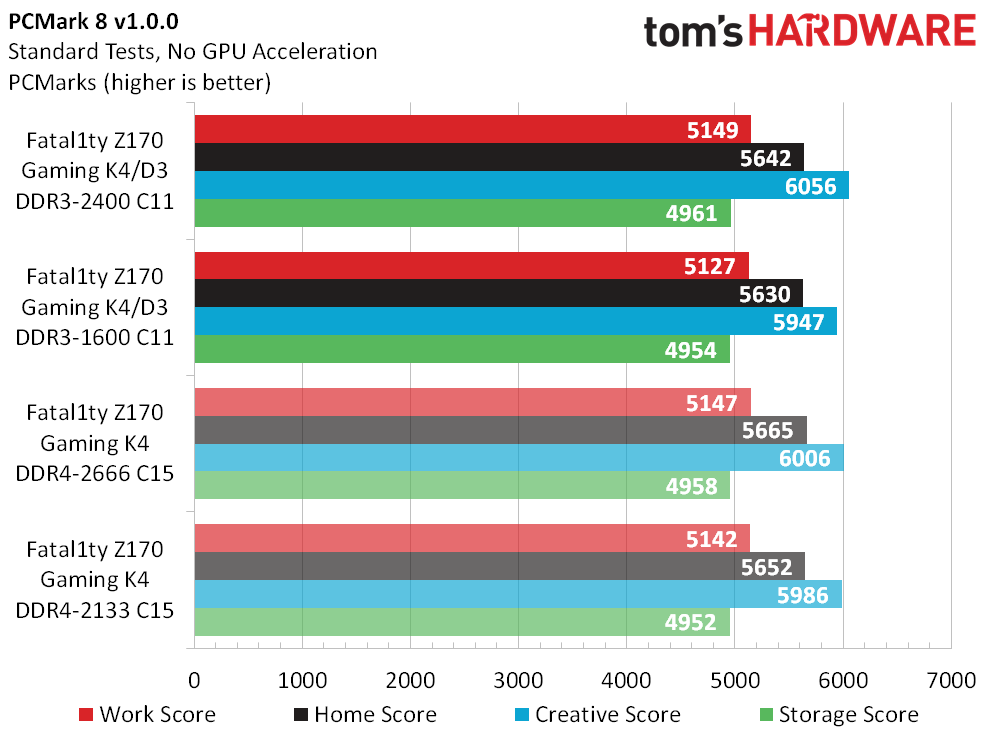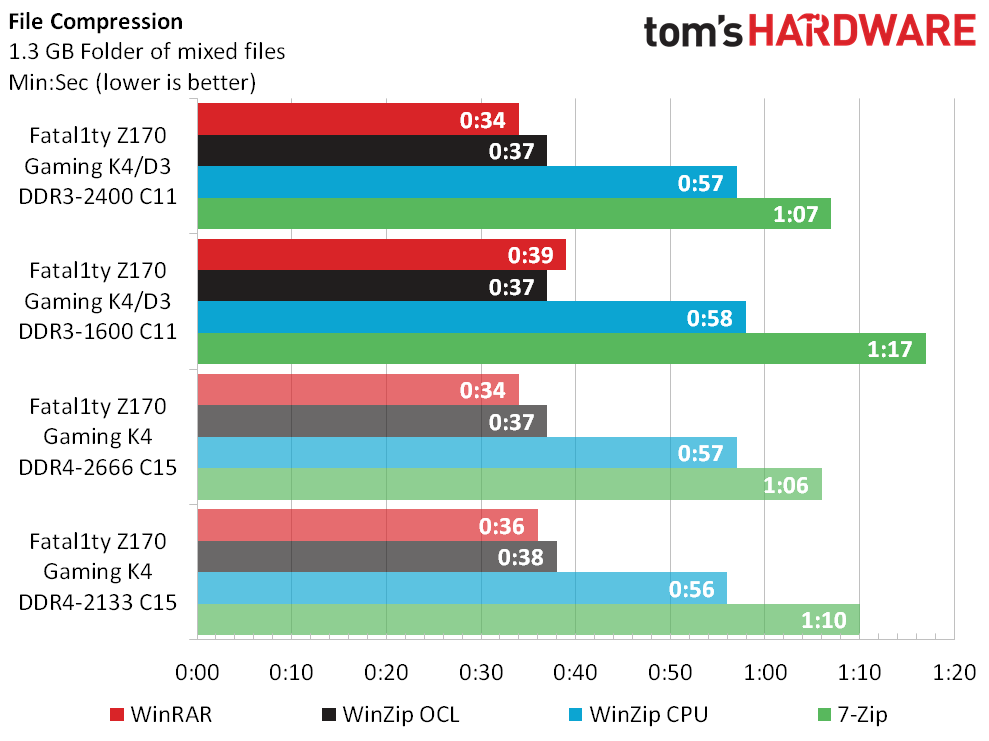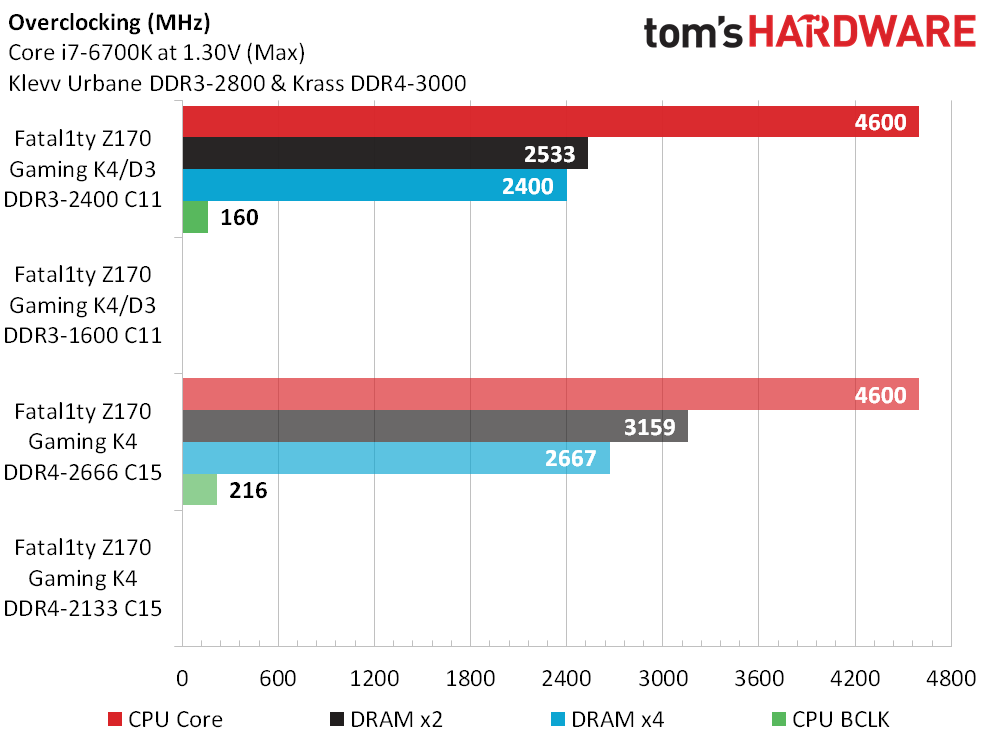Settling The DDR4 Vs DDR3 Debate: ASRock Fatal1ty Z170 Gaming K4/D3 ATX Motherboard Review
Does DDR4 really offer better program performance than DDR3? We compare ASRock's Fatal1ty Z170 Gaming K4/D3 to its previously-reviewed DDR4 sibling.
Why you can trust Tom's Hardware
Benchmarks, Overclocking And DDR3-v-DDR4 Evaluation
Before we could start testing, we had to make sure the comparison is fair. The fact that DDR3-2800 is priced similarly to DDR4-3333 indicates that a comparison to DDR4-2800 wouldn't be equitable. For any given market segment, DDR4 will have a higher data rate and worse timings compared to DDR3.
But are the timings that much worse? Consider that CAS 11 is the most-common latency standard for DDR3-1600, and that CAS 15 is the most-common latency standard for DDR4-2133. A 1GHz cycle takes one nanosecond, and simple math tells us that 1 / 2.133 * 15 = 7ns, while 1 / 1.600 * 11 = 6.875ns. Mathematically, that's not much of an advantage.
Klevv's modules are rated at DDR3-2800 CAS 14 and DDR4-3000 CAS 16, but ASRock's low-cost boards can't hold those data rates. Limiting ourselves to default CAS 11 (DDR3) at 1.50V DIMM and CAS 15 (DDR4) at 1.30V, we found we could still reach DDR3-2400 and DDR4-2666. That gives the DDR3 modules even more of a latency advantage at 4.58ns, compared to DDR4 at 5.625ns. Had we worked any harder to put DDR3 in a good light, DDR4 guys would rightly cry foul.
Test System Configuration
| Software | |
|---|---|
| Graphics | GeForce 353.30 |
| Chipset | Intel INF 10.0.27 |
While the rest of the testbed is carried over from our previous Z170 motherboard reviews, the change in memory for today's comparison required a complete retest.
| Benchmark Settings | |
|---|---|
| 3D Games | |
| Battlefield 4 | Version 1.0.0.1, DirectX 11, 100-sec. Fraps "Tashgar" Test Set 1: Medium Quality Preset, No AA, 4X AF, SSAO Test Set 2: Ultra Quality Preset, 4X MSAA, 16X AF, HBAO |
| Grid 2 | Version 1.0.85.8679, Direct X 11, Built-in Benchmark Test Set 1: High Quality, No AA Test Set 2: Ultra Quality, 8x MSAA |
| Arma 3 | Version 1.08.113494, 30-Sec. Fraps "Infantry Showcase" Test Set 1: Standard Preset, No AA, Standard AF Test Set 2: Ultra Preset, 8x FSAA, Ultra AF |
| Far Cry 3 | V. 1.04, DirectX 11, 50-sec. Fraps "Amanaki Outpost" Test Set 1: High Quality, No AA, Standard ATC, SSAO Test Set 2: Ultra Quality, 4x MSAA, Enhanced ATC, HDAO |
| Adobe Creative Suite | |
| Adobe After Effects CC | Version 12.0.0.404: Create Video which includes 3 Streams, 210 Frames, Render Multiple Frames Simultaneosly |
| Adobe Photoshop CC | Version 14.0 x64: Filter 15.7MB TIF Image: Radial Blur, Shape Blur, Median, Polar Coordinates |
| Adobe Premeire Pro CC | Version 7.0.0 (342), 6.61 GB MXF Project to H.264 to H.264 Blu-ray, Output 1920x1080, Maximum Quality |
| Audio/Video Encoding | |
| iTunes | Version 11.0.4.4 x64: Audio CD (Terminator II SE), 53 minutes, default AAC format |
| Lame MP3 | Version 3.98.3: Audio CD "Terminator II SE", 53 min, convert WAV to MP3 audio format, Command: -b 160 --nores (160 kb/s) |
| Handbrake CLI | Version: 0.99: Video from Canon Eos 7D (1920x1080, 25 FPS) 1 Minutes 22 Seconds Audio: PCM-S16, 48000 Hz, 2-Channel, to Video: AVC1 Audio: AAC (High Profile) |
| TotalCodeStudio 2.5 | Version: 2.5.0.10677: MPEG-2 to H.264, MainConcept H.264/AVC Codec, 28 sec HDTV 1920x1080 (MPEG-2), Audio: MPEG-2 (44.1 kHz, 2 Channel, 16-Bit, 224 kb/s), Codec: H.264 Pro, Mode: PAL 50i (25 FPS), Profile: H.264 BD HDMV |
| Productivity | |
| ABBYY FineReader | Version 10.0.102.95: Read PDF save to Doc, Source: Political Economy (J. Broadhurst 1842) 111 Pages |
| Adobe Acrobat 11 | Version 11.0.0.379: Print PDF from 115 Page PowerPoint, 128-bit RC4 Encryption |
| Autodesk 3ds Max 2013 | Version 15.0 x64: Space Flyby Mentalray, 248 Frames, 1440x1080 |
| Blender | Version: 2.68A, Cycles Engine, Syntax blender -b thg.blend -f 1, 1920x1080, 8x Anti-Aliasing, Render THG.blend frame 1 |
| Visual Studio 2010 | Version 10.0, Compile Google Chrome, Scripted |
| File Compression | |
| WinZip | Version 18.0 Pro: THG-Workload (1.3 GB) to ZIP, command line switches "-a -ez -p -r" |
| WinRAR | Version 5.0: THG-Workload (1.3 GB) to RAR, command line switches "winrar a -r -m3" |
| 7-Zip | Version 9.30 alpha (64-bit): THG-Workload (1.3 GB) to .7z, command line switches "a -t7z -r -m0=LZMA2 -mx=5" |
| Synthetic Benchmarks and Settings | |
| 3DMark 11 | Version: 1.0.5.0, Benchmark Only |
| 3DMark Professional | Version: 1.2.250.0 (64-bit), Fire Strike Benchmark |
| PCMark 8 | Version: 1.0.0 x64, Full Test |
| SiSoftware Sandra | Version 2014.02.20.10, CPU Test = CPU Arithmetic / Multimedia / Cryptography, Memory Bandwidth Benchmarks |
Synthetic Benchmarks
From the outset, we can see that DDR3-1600 C11 defaults seriously hinder the system's Physics score in 3DMark 11. Pushing the memory to DDR3-2400 allows it to nearly match the DDR4-2666, and the DDR4 latency penalty appears inconsequential.







Sandra's Cryptographic Bandwidth test brutally punishes the DDR3-1600 C11 configuration. DDR4-2666 has slightly more bandwidth than DDR3-2400, and the DDR4 latency penalty is only a minor factor in this test. Let's see how it all works in some real-world applications!
3D Game Benchmarks
Battlefield 4 has a 200 FPS limit, which also limits the impact of memory performance at any setting low enough to show the difference. Grid 2 on the other hand favors both low latency and high bandwidth, putting DDR3-2400 C11 on roughly equal footing with DDR4-2666 C15.
Get Tom's Hardware's best news and in-depth reviews, straight to your inbox.




Arma 3 shows a slight preference for the latency advantage of DDR3-2400 C11, compared to DDR4-2666 C15. Far Cry 3 penalizes DDR3-1600, but it's hard to tell whether it's due to bandwidth or latency since the lower data rate corresponds to longer cycle time.
Timed Applications




Adobe Premiere prefers the higher bandwidth of DDR4-2666, but most latency-affected apps put the performance of that memory on par with DDR3-2400.
Power, Heat And Efficiency
The DDR4 in this comparison had LEDs, while the DDR3 did not. LEDs don't consume more power when the memory is loaded though, and that's where the DDR4 board falls behind in spite of the fact that it was set to 1.30V, compared to DDR3 at 1.50V. From these tests, it appears that energy misers would be better off with low-voltage DDR3 than DDR4 of a similar voltage setting.




Thicker heat spreaders on the DDR3 modules required mounting the fan a little higher on the CPU cooler, thus increasing the temperature of the identical CPU voltage regulator of the DDR3 motherboard. Higher temperatures usually cause lower component efficiency, but the DDR3 configuration still pulled less overall energy to produce a greater efficiency rating.
Overclocking
| Frequency And Voltage settings | ||
|---|---|---|
| Row 0 - Cell 0 | ASRock Fatal1ty Z170 Gaming K4/D3 | ASRock Fatal1ty Z170 Gaming K4 |
| BIOS | P1.50 (11/11/2015) | P2.20 (11/11/2015) |
| Base Clock | 100-340 MHz (100 kHz) | 100-340 MHz (100 kHz) |
| CPU Multiplier | 8x-120x (1x) | 8x-120x (1x) |
| DRAM Data Rates | 800-4133 (100/133.3 MHz) | 800-4133 (100/133.3 MHz) |
| CPU Vcore | 0.90-1.52V (5 mV) | 0.90-1.52V (5 mV) |
| System Agent | 0.95-1.35V (10 mV) | 0.95-1.35V (10 mV) |
| CPU I/O | 0.85-1.25V (5 mV) | 0.85-1.25V (5 mV) |
| PCH Voltage | 0.90-1.30V (5 mV) | 0.90-1.30V (5 mV) |
| DRAM Voltage | 1.30-1.65V (5 mV) | 1.00-1.80V (5 mV) |
| CAS Latency | 4-31 Cycles | 4-31 Cycles |
| tRCD | 8-31 Cycles | 8-31 Cycles |
| tRP | 8-31 Cycles | 8-31 Cycles |
| tRAS | 28-63 Cycles | 28-63 Cycles |
Remembering that this DDR3-vs-DDR4 comparison is also a comparison of otherwise-matching motherboards, it's good to see that both version have the same CPU overclocking capability. Unfortunately, DDR3 memory overclocking came up short, and even increased latency values couldn't push stability beyond DDR3-2533. Illustrated more clearly in the DDR4 numbers, memory overclocking stability appears to be limited by the output ceiling of each motherboard's DRAM voltage regulator.
Value
While the price of the DDR4-bearing Fatal1ty Z170 Gaming K4 has recently increased to $135, the Fatal1ty Z170 Gaming K4/D3 is still available for $130. That hands the value win to DDR3, at least for now.
Onboard features and layout advantages were thoroughly discussed in the Fatal1ty Z170 Gaming K4 review. What else can be said of the Fatal1ty Z170 Gaming K4/D3?
Final Thought
Intel insists that Skylake is meant only for use with DDR4 and low-voltage DDR3, but motherboard manufacturers have found standard DDR3 perfectly compatible. While nobody is exactly sure yet how long the CPU will live at higher DDR3-appropriate memory voltage, overclockers have been pushing the CPU core to 1.45V for quite a while. Though the memory controller's slightly higher base voltage should allow it to support even higher signal voltage, we will recommend keeping the memory under 1.55V until we've seen adequate proof of appropriateness for a higher stopping point.
MORE: Best Memory
MORE: Best Motherboards
MORE: How To Choose A Motherboard
MORE: All Motherboard Content
-
NightAntilli If you really want to compare the memory performance in games, you have to pick games where the CPU is easily a bottleneck. GTA V for example. Not BF4... And, using a weak CPU instead also helps. So, an i3 rather than an i7.Reply -
Onus Well well well, looks like I've been ninja'd...Reply
One of the Biostar boards in my H170 roundup has both DDR3 and DDR4 slots, and I do include a comparison, although with a lot less tweaking.
-
Quixit This makes me feel better about my choice of upgrading from DDR3 1866 to DDR4 3000 on my Sky Lake build. Those higher latencies did put me off a bit.Reply -
dark_lord69 This is super relevant to me...Reply
I just bought that board (DDR3 version) and planned on using my old RAM (1.65v) but I don't like that Intel says not to use 1.65v and 1.5v memory. (Didn't find out about that until my board was mounted in my case with heatsink attached and everything.) Sooo... It's installed and everything but I haven't powered it up yet as I believe I may just end up getting new low voltage DDR3 since I am unwilling to risk my 6600K. Very disappointing and defeats the purpose of keeping DDR3 compatible unless you are upgrading from a recent system that doesn't need an upgrade. If I could do it again I would have just gone with DDR4. On the other hand I only paid $83 for that motherboard so it was a rare deal... Follow-up article suggestion: I would love to see/read about under-volting your memory. I'm sure my 1.65v ram can run at 1.35v but I don't know how that will affect it's stability and performance and what settings/ timings I would need to use... -
Onus From the P35 days, so many issues were caused by memory that would not run at stock voltage, that it has become a mantra for me. I don't buy RAM that won't run at its advertised timings on stock (typically JEDEC standard, if applicable) voltage, or LOWER.Reply
-
WKCook I am looking at building a workstation and am now curious.Reply
Would these results hold true for ECC memory?
Thank You . . . . WKCook -
Adhmuz "Consider that CAS 11 is the most-common latency standard for DDR3-1600"Reply
Simply not true, the most common latency for DDR3 1600 is CAS 9, I don't think I've ever even seen a 1600MHz stick with a CAS latency of 11 (other than cheap value RAM), CAS 10 is more common than CAS 11 even, but really it should be CAS 9. In fact CAS 9 can and has been used on DDR3 modules up to 2400MHz, further making your use of CAS 11 on 1600MHz bunk... -
dgingeri We saw this same thing when DDR3 came out. "Is Core 2 better with DDR3?" We saw DDR3 come out at 1066, when DDR2 was just reaching 1066 and even 1200. And no, DDR3 wasn't any faster. As a matter of fact, it was slightly slower. However, DDR3 was able to stretch on and get faster than DDR2 would ever have been able to do.Reply
It doesn't really matter. DDR4 is needed for the future. We need a point where people start adopting it. That point is now. The platform is this one.
So, stop griping about it. -
blazorthon Reply"Consider that CAS 11 is the most-common latency standard for DDR3-1600"
Simply not true, the most common latency for DDR3 1600 is CAS 9, I don't think I've ever even seen a 1600MHz stick with a CAS latency of 11 (other than cheap value RAM), CAS 10 is more common than CAS 11 even, but really it should be CAS 9. In fact CAS 9 can and has been used on DDR3 modules up to 2400MHz, further making your use of CAS 11 on 1600MHz bunk...
Yeah, I see CAS 9 and CAS 10 much more often than CAS 11 in DDR3-1600 these days. CAS 11 was more common when DDR3-1600 first came out, but that was years ago and CAS 11 isn't so common any more except for higher frequencies like DDR3-2133.
Still, to be fair, the common CAS 15 for DDR4 is common not only for the lower frequencies but doesn't change much even up to the higher frequencies where is is less of a liability. Either way, memory latency is usually less of a factor in performance than data rate and the small differences are rarely a big deal. Now that DDR4 has finally reached price parity, there is a lot less reason to not go for Skylake if building new. -
Adhmuz Reply
Let me elaborate, I've been buying DDR3 1600MHz since early 2008, never have I purchased anything other than CAS 9 memory, hence why using CAS 11 in the article felt out of place. It just seems wrong to not do the old standard justice in the comparison, it has served very well for the last almost 10 years, heck my very first triple channel kit of, get this, OCZ RAM is still running strong at CAS 9.17557530 said:Yeah, I see CAS 9 and CAS 10 much more often than CAS 11 in DDR3-1600 these days. CAS 11 was more common when DDR3-1600 first came out, but that was years ago and CAS 11 isn't so common any more except for higher frequencies like DDR3-2133.
Still, to be fair, the common CAS 15 for DDR4 is common not only for the lower frequencies but doesn't change much even up to the higher frequencies where is is less of a liability. Either way, memory latency is usually less of a factor in performance than data rate and the small differences are rarely a big deal. Now that DDR4 has finally reached price parity, there is a lot less reason to not go for Skylake if building new.
Any new system being built should be DDR4, agree with you 100% there, you'd have to be crazy otherwise.


